Álcool polivinílico (PVA) é uma matéria-prima fundamental para a produção de vinilon e também é utilizada na produção de adesivos, emulsificantes e outros produtos. No processo de produção de PVA, a polimerização em solução é utilizada para garantir um grau estreito de distribuição da polimerização, baixa ramificação e boa cristalinidade. A taxa de polimerização do VAM é rigorosamente controlada em aproximadamente 60%. Devido ao controle da taxa de polimerização durante o processo de polimerização do VAM, aproximadamente 40% da Monômero de acetato de vinila (VAM) permanece não polimerizado e requer separação, recuperação e reutilização. Portanto, a pesquisa sobre o processo de recuperação de VAM é um componente crucial do processo de produção de PVA. Existe uma relação polímero-monômero entre Acetato de etileno vinila (EVA) e monômero de acetato de vinila (VAM). O monômero de acetato de vinila é uma das matérias-primas básicas para a fabricação do polímero etileno acetato de vinila.
Este artigo utiliza o software de simulação química Aspen Plus para simular e otimizar o processo de recuperação de VAM. Estudamos como as configurações do processo na primeira, segunda e terceira torres de polimerização afetam a unidade de produção. Encontramos as melhores configurações para economizar água na extração e reduzir o consumo de energia. Esses parâmetros fornecem uma base teórica importante para o projeto e a operação da recuperação de VAM.
1 Processo de Recuperação de Monômero de Acetato de Vinila
1.1 Processo de Simulação
Este processo inclui a primeira, a segunda e a terceira torres de polimerização no processo de recuperação do monômero de acetato de vinila. O diagrama de fluxo detalhado é mostrado na Figura 1.
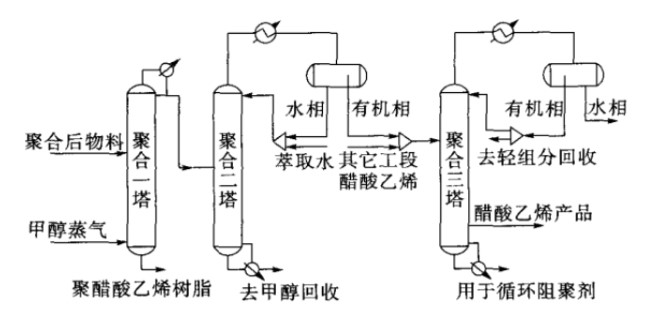
1.2 Modelo Termodinâmico e Seleção de Módulos
A unidade de recuperação de monômero de acetato de vinila da planta de álcool polivinílico processa principalmente um sistema polar composto por acetato de vinila, metanol, água, acetato de metila, acetona e acetaldeído, com separação líquido-líquido entre acetato de vinila e água. O equipamento principal da unidade de recuperação de monômero de acetato de vinila da planta de álcool polivinílico foi simulado utilizando o software Aspen Plus. O módulo RadFrac foi utilizado para a torre de destilação e o módulo Decanter para o separador de fases.
2 Resultados da Simulação
Realizamos uma simulação de processo na unidade de recuperação de monômero de acetato de vinila na planta de álcool polivinílico. A Tabela 3 mostra uma comparação dos resultados da simulação com os valores reais para a logística principal. Como mostrado na Tabela 3, os resultados da simulação estão em boa concordância com os valores reais, portanto, este modelo pode ser usado para otimizar ainda mais os parâmetros e o fluxo do processo.
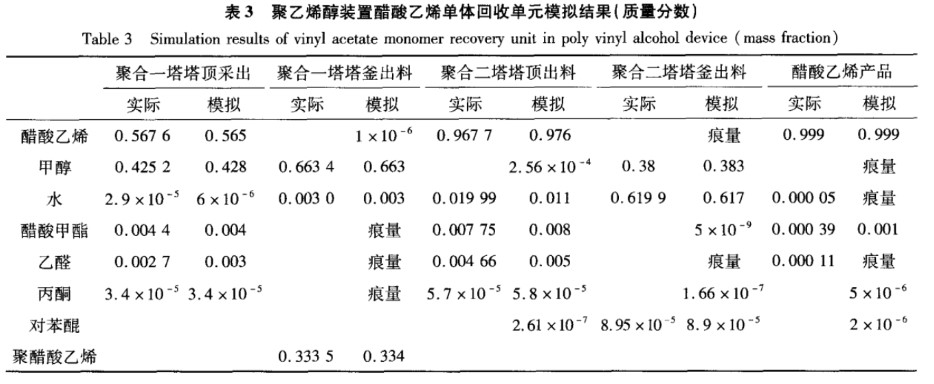
3 Otimização de Parâmetros de Processo
3.1 Determinação da quantidade de metanol de stripping
A Torre de Polimerização 1 extrai o monômero de acetato de vinila (VAM) do fluxo remanescente após a polimerização. Ela utiliza vapor de metanol na parte inferior para aquecimento. A quantidade correta de metanol é importante para o bom funcionamento da torre. Este estudo analisa como diferentes quantidades de metanol afetam a fração mássica de PVA na parte inferior da torre e a fração mássica de VAM na parte superior, assumindo que a alimentação permanece a mesma e o projeto da torre é constante.
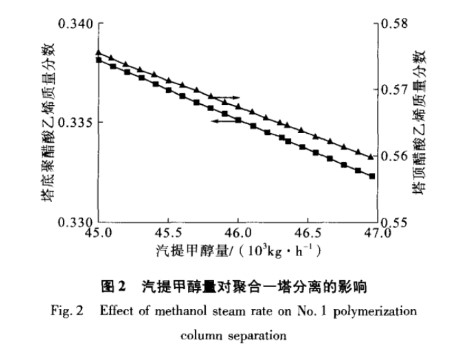
Conforme mostrado na Figura 2, quando a capacidade térmica necessária para a separação na Torre de Polimerização 1 é satisfeita, o aumento da quantidade de metanol de stripping reduz a fração mássica de PVA na parte inferior e a fração mássica de VAM na parte superior. A quantidade de metanol de stripping tem uma relação linear com a fração mássica de PVA na parte inferior e a fração mássica de VAM na parte superior.
3.2 Otimização da Posição de Alimentação na Torre de Polimerização 2
Na Torre de Polimerização 2, uma torre de destilação extrativa, os locais de entrada do solvente e da alimentação afetam significativamente o funcionamento da separação. Esta coluna utiliza destilação extrativa. Com base nas propriedades físicas do extratante e da alimentação mista, o extratante deve ser adicionado pela parte superior da coluna. A Figura 3 mostra como a posição da alimentação da mistura afeta a fração mássica de metanol na parte superior e a carga do refervedor na parte inferior, mantendo as demais configurações da simulação inalteradas.
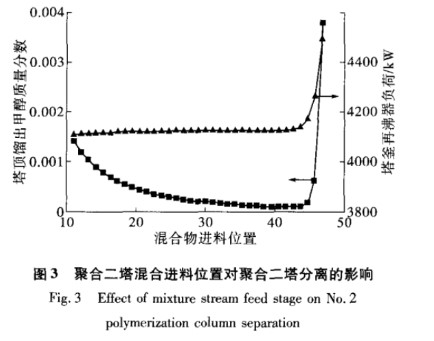
3.3 Otimização da quantidade de água de extração na coluna de polimerização 2
Na Coluna de Polimerização 2, a destilação extrativa é usada para separar o azeótropo de acetato de vinila e metanol. Ao adicionar água ao topo da coluna, o azeótropo é rompido, permitindo a separação das duas substâncias. A vazão da água de extração tem um grande impacto na eficiência da separação desses materiais pela Coluna de Polimerização 2. Com configurações de simulação consistentes, observei como a quantidade de água de extração afetava a fração mássica de metanol no topo e a carga do refervedor na base da coluna. Os resultados são mostrados na Figura 4.
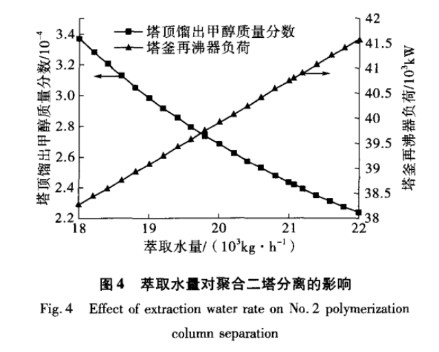
3.4 Otimizando a taxa de refluxo na coluna de polimerização 3
Na Coluna de Polimerização 3, a razão de refluxo é importante para separar o acetato de vinila de substâncias mais leves, como acetato de metila e traços de água. Isso melhora a qualidade do acetato de vinila obtido da corrente lateral. Mantivemos as configurações de simulação constantes e estudamos como a razão de refluxo afeta tanto a fração mássica de acetato de vinila da corrente lateral quanto a carga do refervedor. Os resultados do cálculo são mostrados na Figura 6. Manter a razão de refluxo da torre de polimerização em torno de 4 ajuda a garantir que o acetato de vinila da linha lateral atenda aos padrões de qualidade e mantenha a carga do refervedor baixa.
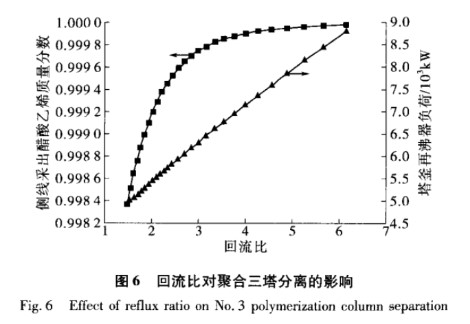
4. Conclusão
(1) Utilizando o software AspenPlus, um modelo termodinâmico adequado é selecionado para simular todo o processo de recuperação do monômero de acetato de vinila da planta de álcool polivinílico. Os resultados da simulação estão em boa concordância com os valores reais e podem ser usados para orientar o projeto do processo e a otimização da produção da planta.
(2) Com base no estabelecimento de uma simulação de processo correta, a influência dos parâmetros de processo da torre de polimerização 1, torre de polimerização 2 e torre de polimerização 3 na planta é investigada, e os parâmetros de processo ideais são determinados. Quando o acetato de vinila atende aos padrões de separação necessários, podemos economizar água de extração e reduzir o consumo de energia.
Site: www.elephchem.com
Whatsapp: (+)86 13851435272
E-mail: admin@elephchem.com